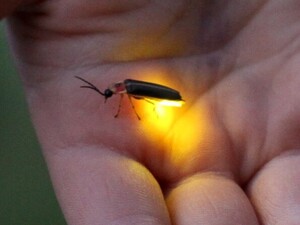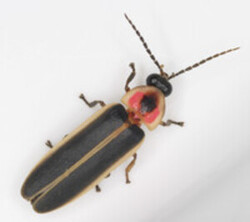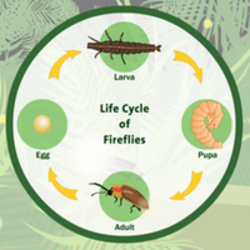Common Eastern Firefly (Photinus pyralis)
Photinus pyralis, also commonly referred to as the Common Eastern Firefly, Big Dipper Firefly, or Lightning Bug, is a species of flying beetle. The Common Eastern Firefly is the most common firefly species in North America [1]. These beetles are known for the show they put on in late spring and early summer months by emitting a bioluminescence that is often used to attract mates [1].

Taxonomy
Kingdom: Animalia
Phylum: Anthropoda
Class: Insecta
Order: Coleoptera
Family: Lampyridae
Genus: Photinus

Description
The average adult beetle is around 9 to 19 mm (0.4 to 0.7 inches) long, [1] consisting of three main sections including the head, thorax and abdomen. The shield-like plate covering the beetle's head has a black dot in the center with red and yellow outlining [2]. The wing covers are black, outlined in yellow, and often leathery in texture [1]. Underneath these wing covers are pairs of wings and an abdomen that is black in color until the last segment, which is yellow. The last segment is the bioluminescent organ found to "glow". The beetles are have a hard exoskeleton with 6 jointed legs, two antenna, and compound eyes located on either side of the head, [3] all of which are blackish-brown in color.
Bioluminescence
The creation of the beetle's bioluminescent light is formed by the presence of oxygen, magnesium, and adenosine triphosphate (ATP), which produce the complex organic compound luciferin. As luciferin oxidizes, a "cold light" is emitted [4]. The term "cold light" refers to the majority of produced energy being emitted in the form of light, with very little released as heat [1]. Male and female Common Eastern Fireflies are found to have different lightning patterns. The male Common Eastern Firefly has a single sustained yellow light while flying upwards, forming the letter "J" [5]. Female Common Eastern Fireflies are often found on long blades of grass emitting their own flashing signal to attract a male. While the bioluminescence is often used to attract a mate, it may also be used to warn predators of their toxicity [6]. Additionally, female Common Eastern Fireflies may be found luring in males by mimicking mating signals as bait [6].
Habitat
These beetles are nocturnal and crepuscular (they are most active at night and during dawn and dusk). The larvae can be found living on damp ground near streams. The adult beetles are typically found in meadows, wetlands, and edges of woodlands. Generally, Common Eastern Fireflies are found in areas with wet soils and tall grasses [3].
Life Cycle
The Common Eastern Firefly goes through metamorphosis as the beetle transforms from larvae to adult. In the early stages, it can be seen that both the eggs and larvae emit a soft glow to ward off predators [1].

Eggs: Eggs are about 1 mm in length and spherical in shape. They are found to hatch 4 weeks after being laid [1].
Larva: Larvae live around 1 to 2 years. The larvae may be found eating insects, snails, and earthworms [7].
Pupa: Pupates are found within damp soil requiring 9 to 15 days to fully mature, which is dependent on soil temperature [8].
Adult: Adult fireflies live around 30 days, with female fireflies laying up to 500 eggs in a season [1].
Ecosystem Importance
The Common Eastern Firefly acts as a predator species, and affects species that try to consume it, therefore contributing to food web stability [9]. Larvae and adult fireflies can be found eating insects, snails, and earthworms [1]. While not many species feed off of the Common Eastern Firefly due to their toxicity, invertebrate predators such as spiders are found to be least affected by the toxins [9].
Conservation Status
According to the IUCN Red List of Threatened Species, as of 2020, the Photinus pyralis species is listed as "Least Concern"[10]. However, the overall abundance of firefly species are seen to be dwindling due to a variety of threats. Factors such as habitat loss, light pollution, and the use of pesticides are contributing to the decrease in numbers of fireflies [11].
References
[1] iNaturalist. (n.d.). Photinus pyralis. iNaturalist. Retrieved March 29, 2025, from https://www.inaturalist.org/taxa/129350-Photinus-pyralis
[2] Missouri Department of Conservation. (n.d.). Fireflies (lightning bugs). Missouri Department of Conservation. Retrieved March 29, 2025, from https://mdc.mo.gov/discover-nature/field-guide/fireflies-lightning-bugs#:~:text=The%20adults%20of%20most%20species,covers%20the%20head%20from%20above
[3] University of Michigan. (n.d.). Photinus pyralis (common eastern firefly). Animal Diversity Web. Retrieved March 29, 2025, fromhttps://animaldiversity.org/accounts/Photinus_pyralis/#:~:text=The%20common%20eastern%20firefly%20is,%2C%20thorax%2C%20and%20abdomen
[4] Branchini, B. (n.d.). Bioluminescence: The science behind the glow. Photobiology. Retrieved March 29, 2025, from http://photobiology.info/Branchini2.html
[5] National Park Service. (n.d.). Firefly flash patterns. U.S. Department of the Interior. Retrieved March 29, 2025, from https://www.nps.gov/grsm/learn/nature/firefly-flash-patterns.htm
[6] Finger Lakes Land Trust. (n.d.). Firefly bioluminescence. Finger Lakes Land Trust. Retrieved March 29, 2025, from https://www.fllt.org/firefly-bioluminescence/#:~:text=The%20mostly%20nocturnal%20firefly%20larvae,bats%20that%20they%20are%20poisonous.
[7] Neely, B. (n.d.). Firefly larvae and their development. LSU AgCenter. Retrieved March 29, 2025, from https://www.lsuagcenter.com/profiles/bneely/articles/page1587050468972#:~:text=Larval%20Photinus%20can%20be%20found,to%20mature%20depending%20on%20temperature.
[8] Life on CSG Pond. (n.d.). Common eastern firefly. Life on CSG Pond. Retrieved March 29, 2025, from https://www.lifeoncsgpond.com/common-eastern-firefly#:~:text=At%20dusk%2C%20a%20flying%2C%20flashing,with%20narrow%20yellow%20side%20margins.
[9] The Xerces Society. (2019). Firefly conservation and management guidelines. The Xerces Society for Invertebrate Conservation. Retrieved March 29, 2025, from https://xerces.org/sites/default/files/publications/19-049_01_Firefly%20guidelines_web_1.pdf
[10] IUCN. (n.d.). Photinus pyralis (common eastern firefly). International Union for Conservation of Nature. Retrieved March 29, 2025, from https://www.iucnredlist.org/species/164046430/166771623#assessment-information
[11] Miller, R. (2020, July 29). Fireflies, glow worms, and lightning bugs: The decline of a luminous species. Yale E360. Retrieved March 29, 2025, from https://e360.yale.edu/features/fireflies-glow-worms-lightning-bugs-decline